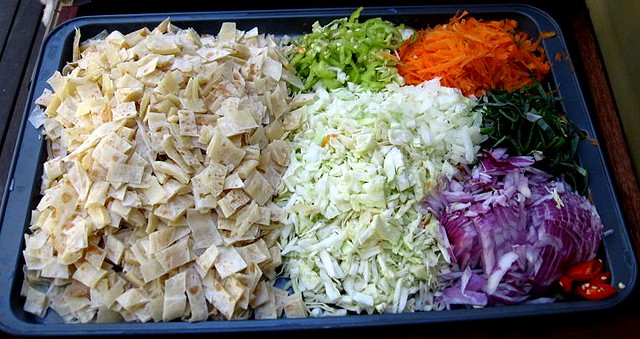
Kothu, or Koththu Roti is a Sri Lankan dish, made from a Sri Lankan roti called "Godhamba Roti" and Vegetables, Egg, and/or Meat, and various spices. A delicious hot kothu can be found in almost all parts of Sri Lanka, and is generally eaten as a dinner meal. The most common varieties of Kothu are beef or chicken, with egg and vegetable Kothus also available for vegetarians. A new ingredient, cheese, has only recently been introduced but already has a strong following and seems to be becoming a mainstay.
It is traditional to make the kothu on a heated iron sheet, used specifically for the purpose, and the cutting up and mixing of the kothu is done using two other rather blunt metal blades. This clashing of metal on metal creates a very distinctive sound, and come late evening the beat of kottu being prepared can be heard rising up from any small roadside restaurant.

Kothu Origins
Kothu Roti originated in Batticaloa, in the Eastern parts Sri Lanka during the early 70s by the local Tamil people. Etymologically the name is from the Tamil language meaning "chopped roti". (Chopped wheat roti mixed with curry sauce) The basic rotti is made of Gothamba flour. The name itself is Tamil Gothamba (A form of Kathamba-meaning a flour made out of a variety of grains-referring to the white flour, and roti (ROTTI). Slowly it has spread to other parts of the country as the strife within the country continued and has now caught up and has become extremely popular. It can also be found in many Sri Lankan restaurants in other countries, where there is a large Sri Lankan population.
Kothu is now a food that has successfully transcended social boundaries in Sri Lanka. Kothu, which used to be a cheap, takeaway meal for the lower classes has now become almost a staple diet for the upper classes as well, specially among the young and outgoing. It is now a common practice for nightclub and party goers in Sri Lanka to end their nights with a kothu as a midnight snack.
As restaurateurs explore with ideas, a variety of kothu variations have become available. The main ones are where the roti is substituted for pittu or string hoppers, hence the pittu kothu and string hopper kothu.

Good kothu can be found at almost any small boutique that serves it anywhere in the island, and is often made at home, using godhamba roti cut with ordinary knives, and the appropriate ingredients.
From Wikipedia, the free encyclopedia
From Wikipedia, the free encyclopedia

No comments:
Post a Comment